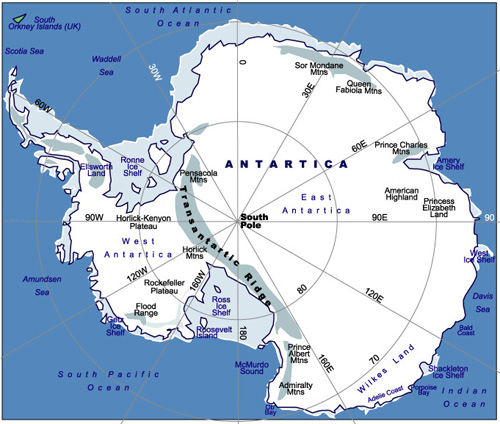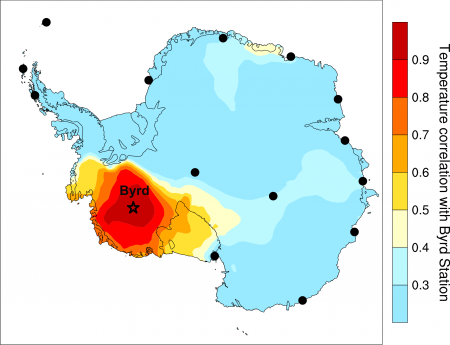It looks like you're using an Ad Blocker.
Please white-list or disable AboveTopSecret.com in your ad-blocking tool.
Thank you.
Some features of ATS will be disabled while you continue to use an ad-blocker.
9
share:
Huge iceberg breaks away from the Pine Island glacier in the Antarctic
9. July 2013:
www.awi.de... edb235fb000a9
files.abovetopsecret.com...
files.abovetopsecret.com...

Animation ..
www.awi.de...

9. July 2013:
Bremerhaven, 9 July 2013. Yesterday (8 July 2013) a huge area of the ice shelf broke away from the Pine Island glacier, the longest and fastest flowing glacier in the Antarctic, and is now floating in the Amundsen Sea in the form of a very large iceberg. Scientists of the Alfred Wegener Institute, Helmholtz Centre for Polar and Marine Research have been following this natural spectacle via the earth observation satellites TerraSAR-X from the German Space Agency (DLR) and have documented it in many individual images.
Scientists from the American space agency NASA discovered the first crack in the glacier tongue on 14 October 2011 when flying over the area. At that time it was some 24 kilometres long and 50 metres wide. ”As a result of these cracks, one giant iceberg broke away from the glacier tongue. It measures 720 square kilometres and is therefore almost as large as the city of Hamburg“, reports Prof. Angelika Humbert, ice researcher at the Alfred Wegener Institute.
”Above the large crack, the glacier last flowed at a speed of twelve metres per day“, reports Humbert’s colleague Dr. Dana Floricioiu from DLR. And Nina Wilkens, PhD graduate in Prof. Humbert’s team, adds: “Using the images we have been able to follow how the larger crack on the Pine Island glacier extended initially to a length of 28 kilometres. Shortly before the “birth” of the iceberg, the gap then widened bit by bit so that it measured around 540 metres at its widest point.“
Are ice breaks caused by climate change? Angelika Humbert does not so far see any direct connection: “The creation of cracks in the shelf ice and the development of new icebergs are natural processes“, says the glaciologist. However, the Pine Island glacier, which flows from the Hudson mountains to the Amundsen Sea, was the fastest flowing glacier in the Western Antarctic with a flow speed of around 4 kilometres per yeaar.
For the Western Antarctic ice shelf, an even faster flow of the Pine Island glacier would presumably have serious consequences. “The Western Antarctic land ice is on land which is deeper than sea level. Its “bed” tends towards the land. The danger therefore exists that these large ice masses will become unstable and will start to slide“, says Angelika Humbert. If the entire West Antarctic ice shield were to flow into the Ocean, this would lead to a global rise in sea level of around 3.3 metres.
www.awi.de... edb235fb000a9
files.abovetopsecret.com...
files.abovetopsecret.com...

Animation ..
www.awi.de...

edit on 12-7-2013 by MariaLida because: (no reason given)
West Antarctica warming more than expected
December 23, 2012
www2.ucar.edu...

Pine Island glacier loss must force another look at sea-level forecasts as giant iceberg is spawned
www.climatecodered.org...
ScienceShot: The Big Unknown in Sea-Level Rise
14 May 2013
news.sciencemag.org...
December 23, 2012
The rate of increase is three times faster than the average temperature rise around the globe for the same period.
www2.ucar.edu...

Pine Island glacier loss must force another look at sea-level forecasts as giant iceberg is spawned
Recent research by Blancon et. al published in Nature in 2009 examining the paleoclimate record shows sea level rises of 3 metres in 50 years due to the rapid melting of ice sheets 120,000 years ago. Mike Kearney, of the University of Maryland, said it's "within the realm of possibility" that global warming will trigger a sudden collapse of the West Antarctic ice sheet, which could lead to a rapid increase in sea levels like that predicted by the study.
www.climatecodered.org...
ScienceShot: The Big Unknown in Sea-Level Rise
14 May 2013
Even 90 centimeters of sea-level rise would hit coastal areas hard, producing routine flooding in low-lying cities such as Miami and New York.
news.sciencemag.org...
edit on 12-7-2013 by MariaLida because: (no reason
given)
All right I like pictures.
I think that these breakoffs are a natural response to warming, something to help balance what is going on so the earth can go on supporting life. It shows me a sort of intelligent design, it seems that the response being random is not possible, although randoms do fit together to form patterns after a while. Cause and reaction, but it still seems that this perpetual cycle almost has an intelligent design.
I think that these breakoffs are a natural response to warming, something to help balance what is going on so the earth can go on supporting life. It shows me a sort of intelligent design, it seems that the response being random is not possible, although randoms do fit together to form patterns after a while. Cause and reaction, but it still seems that this perpetual cycle almost has an intelligent design.
edit on 12-7-2013 by
rickymouse because: (no reason given)
Any idea about its dimensions and how it could affect the climate/oceans/continents/shorelines/marine creatures in anyway?
edit on 12-7-2013 by
hp1229 because: (no reason given)
While the Artic ice shelf in Greenland is receding, there's evidence that the Antarctic shelf is expanding. To have evidence of iceberg birthing
means either that the mass of ice is naturally regulating itself, or the reports are wrong.
Hypothetically, both poles melting means a rise in sea levels, and coastal restructuring, but I've not heard that that is the case. Not yet, anyway.
Hypothetically, both poles melting means a rise in sea levels, and coastal restructuring, but I've not heard that that is the case. Not yet, anyway.
reply to post by QuantriQueptidez
A business journal, dated to April, and a science paper, dated July. Ymmv?
A business journal, dated to April, and a science paper, dated July. Ymmv?
a reply to: MariaLida
Here we are, in 2014, and CNN talked about the iceberg tonight.
www.cnn.com...
Slate is calling it the
www.slate.com...
Here we are, in 2014, and CNN talked about the iceberg tonight.
A massive iceberg with an area almost twice the size of Atlanta is moving into the ocean off Antarctica and could threaten shipping during the Antarctic winter, scientists say.
www.cnn.com...
Slate is calling it the
the size of Singapore.
www.slate.com...
a reply to: Druid42
The kicker with Antarctica is that you can superimpose the United States over it, and still have room on all 4 sides before seeing open water. It's a big big place. As I understand it, it is thickening in some places while going the other way in other areas. There are also recent papers suggesting sub-ice volcanoes. Real and active ones. They speculate the 3-4 kilometers of Ice is just too much in altitude (from down there, in perspective) to punch through. So.... It's a crazy place.
The kicker with Antarctica is that you can superimpose the United States over it, and still have room on all 4 sides before seeing open water. It's a big big place. As I understand it, it is thickening in some places while going the other way in other areas. There are also recent papers suggesting sub-ice volcanoes. Real and active ones. They speculate the 3-4 kilometers of Ice is just too much in altitude (from down there, in perspective) to punch through. So.... It's a crazy place.
a reply to: Wrabbit2000
We have some evidence of volcanoes that erupted during the various Ice Ages to form peculiar structures called tuyas.
The ones in Antarctica likely resemble these! Even volcanoes can't punch through kilometers of ice. Water is a pretty amazing material. There are also some large volcanoes above the ice sheet, though - Erebus is one.
We have some evidence of volcanoes that erupted during the various Ice Ages to form peculiar structures called tuyas.
The ones in Antarctica likely resemble these! Even volcanoes can't punch through kilometers of ice. Water is a pretty amazing material. There are also some large volcanoes above the ice sheet, though - Erebus is one.
edit on 21Tue, 22
Apr 2014 21:23:00 -0500America/ChicagovAmerica/Chicago4 by Greven because: (no reason given)
new topics
-
WF Killer Patents & Secret Science Vol. 1 | Free Energy & Anti-Gravity Cover-Ups
General Conspiracies: 1 hours ago -
Hurt my hip; should I go see a Doctor
General Chit Chat: 2 hours ago -
Israel attacking Iran again.
Middle East Issues: 3 hours ago -
Michigan school district cancels lesson on gender identity and pronouns after backlash
Education and Media: 3 hours ago -
When an Angel gets his or her wings
Religion, Faith, And Theology: 4 hours ago -
Comparing the theology of Paul and Hebrews
Religion, Faith, And Theology: 5 hours ago -
Pentagon acknowledges secret UFO project, the Kona Blue program | Vargas Reports
Aliens and UFOs: 6 hours ago -
Boston Dynamics say Farewell to Atlas
Science & Technology: 6 hours ago -
I hate dreaming
Rant: 7 hours ago -
Man sets himself on fire outside Donald Trump trial
Mainstream News: 9 hours ago
top topics
-
The Democrats Take Control the House - Look what happened while you were sleeping
US Political Madness: 9 hours ago, 18 flags -
In an Historic First, In N Out Burger Permanently Closes a Location
Mainstream News: 11 hours ago, 16 flags -
A man of the people
Medical Issues & Conspiracies: 17 hours ago, 11 flags -
Man sets himself on fire outside Donald Trump trial
Mainstream News: 9 hours ago, 9 flags -
Biden says little kids flip him the bird all the time.
Politicians & People: 9 hours ago, 9 flags -
Michigan school district cancels lesson on gender identity and pronouns after backlash
Education and Media: 3 hours ago, 6 flags -
Pentagon acknowledges secret UFO project, the Kona Blue program | Vargas Reports
Aliens and UFOs: 6 hours ago, 6 flags -
Israel attacking Iran again.
Middle East Issues: 3 hours ago, 5 flags -
WF Killer Patents & Secret Science Vol. 1 | Free Energy & Anti-Gravity Cover-Ups
General Conspiracies: 1 hours ago, 5 flags -
Boston Dynamics say Farewell to Atlas
Science & Technology: 6 hours ago, 4 flags
active topics
-
Israel attacking Iran again.
Middle East Issues • 25 • : charlest2 -
Michigan school district cancels lesson on gender identity and pronouns after backlash
Education and Media • 8 • : TheMichiganSwampBuck -
I Guess Cloud Seeding Works
Fragile Earth • 29 • : Justoneman -
Man sets himself on fire outside Donald Trump trial
Mainstream News • 40 • : Vermilion -
When an Angel gets his or her wings
Religion, Faith, And Theology • 5 • : randomuser2034 -
Anyone one else having Youtube problems
Computer Help • 11 • : charlyv -
The Democrats Take Control the House - Look what happened while you were sleeping
US Political Madness • 68 • : Mahogani -
Candidate TRUMP Now Has Crazy Judge JUAN MERCHAN After Him - The Stormy Daniels Hush-Money Case.
Political Conspiracies • 404 • : Zanti Misfit -
In an Historic First, In N Out Burger Permanently Closes a Location
Mainstream News • 10 • : Degradation33 -
SC Jack Smith is Using Subterfuge Tricks with Donald Trumps Upcoming Documents Trial.
Dissecting Disinformation • 100 • : WeMustCare
9
